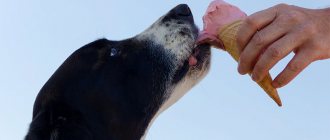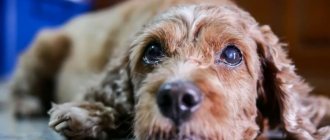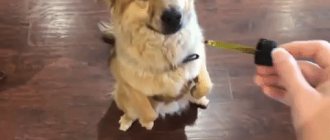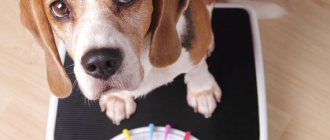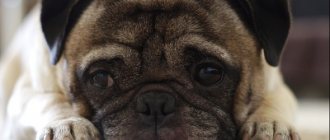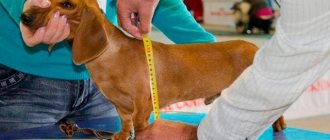Like other senses in an animal, vision is a real source for receiving information coming from the world around the dog. Loss of the ability to see, complete or partial, leads to a decrease in the pet’s quality of life.
The causes of the development of the pathological condition can be various mechanical damage to the eye itself, genetic predisposition, and various systemic pathologies. Neoplasia, degenerative changes caused by age-related changes or infectious processes can provoke blindness in a four-legged friend.
The first signs of blindness appear in a dog - it is necessary to contact a veterinary clinic. The specialist will conduct a number of necessary studies and prescribe adequate possible therapy. If it is not possible to completely restore lost vision, the veterinarian will help develop a plan for the most comfortable adaptation of the pet to the environment, thereby increasing the quality of life.
Possible causes of blindness in dogs
Injuries, developmental abnormalities, or infectious agents can cause various diseases of the visual system:
- keratitis, keratoconjunctivitis;
- ectopia lens;
- cataract;
- uveitis (panuveitis, iridocyclitis, choroiditis);
- glaucoma;
- partial and complete retinal detachment;
- retinopathy;
- inflammation of the optic nerve;
- etc.
Age-related changes similar to eye diseases:
- iris atrophy;
- nuclear sclerosis.
Signs of aging are considered as a variant of the norm, but other pathologies can occur along with them, actually affecting the animal’s vision.
Entropy or entropion
Due to the continuous contact of the mucous membrane with the eyelashes and hair of the animal, the cornea of the eye is injured, which leads to pain, increased tear production and, ultimately, damage to the cornea. Entropion can be a congenital condition or develop as a result of chronic strabismus due to discomfort or scarring of the eyelids. This disease is not a cosmetic defect, but a serious problem that requires immediate attention to a veterinary ophthalmologist!
How to understand that a dog sees worse
The owner of the dog spends most of the time with it, so changes in the animal’s behavior are noticed immediately. This is especially true for sudden deterioration of vision. At the same time, a normally normally oriented dog suddenly becomes more careful and measured. The animal lowers its head lower to the ground, the stride can be shortened or lengthened.
It is important to understand that at home a dog can see poorly, but can navigate well out of habit. Some owners note that after rearranging the furniture, pets feel insecure when walking in the house. Sometimes they even jump into a place where, for example, a sofa could previously have stood. They bump into other objects.
Therefore, the development of partial or complete blindness in a pet is often judged in an unfamiliar environment. A completely different approach if the visual impairment developed gradually.
Such dogs feel more confident and may initially appear completely healthy, compensating for poor vision at the expense of other senses. In this case, there is no sudden effect when eye function is suddenly disrupted. Ophthalmological pathologies or age-related changes that extend along the course are more calmly perceived, since there is no rapid gradation and sudden blindness. Animals orient themselves well, getting used to the gradual deterioration of vision when idle. Such conditions can only be diagnosed using special tests during an examination by a doctor.
A favorable course, which is rarely visually noticed by pet owners, often has a more unfavorable prognosis. Chronic and degenerative age-related changes in eye structures are difficult to treat. In this regard, when performing a physical examination of even healthy pets, veterinarians often pay a lot of attention to the eyes; this is the only way to fully assess the condition of the underlying structures and appendage apparatus.
Cherry eye
“Cherry eye” - “cherry eye” - this pathology is often called “inflammation of the third eyelid”, “adenoma of the third eyelid”.
Dogs have three eyelids: two that are clearly visible and one extra eyelid (called the third eyelid), which is usually hidden under the inner corner of the eye. The third eyelid contains the gland that produces tears. Usually this gland is barely noticeable, but some dogs have a congenital weakness of the ligaments that hold it in place. When these ligaments fail, the gland jumps out of its normal position and looks like a “cherry” stuck in the inner corner of the eye. Because the condition often has a genetic basis, both eyes are usually affected over time. To treat cherry eye, the veterinarian performs simple surgery to return the gland to its normal position.
Diagnosis of vision impairment
A complete diagnosis of eye pathologies is possible only in a veterinary clinic. However, anamnesis is an important point for making a diagnosis. That is, information about the pet from the words of the owner. This provides certain leads for the veterinarian to conduct in-depth research.
After collecting an anamnesis and a general clinical examination of the pet, the doctor conducts an ophthalmological examination, which includes special research methods. Thanks to it, it is possible to establish the depth and nature of the damage to the eye, as well as the structures involved - from the adnexa to the optic nerve.
- Obstacle course. Any kind of obstacles are placed between the owner and the dog (chairs, baskets, toys), the owner calls the pet, then it is necessary to monitor the movements of the animal. You can also perform this test with the lights on and off to evaluate the health of your retina. If the dog moves hesitantly or even hits objects along the way, then blindness is judged to be developing.
- Threat reaction. Perform one by one, covering one eye. The doctor sharply moves his hand near the animal’s muzzle, as if swinging. It is important not to create air currents, since the skin in the area of the nose and muzzle is extremely sensitive, which can result in a false positive test result. A pet that does not respond to an external stimulus with an open eye is presumably blind.
- Cotton ball tracking test. The contrasting white ball should be in the animal's field of vision as it falls to the floor. Normally, the dog should follow him with his gaze.
- Pupillary reaction to light. Bright light affects the conduction system of the eye, sensitive cells of the retina and nerves (oculomotor, visual). It is especially indicative for unilateral lesions to assess the condition of the retina. If you apply a bright light to an eye with a clear sign of blindness, then on the second (healthy) eye there will be a noticeable constriction of the pupil. This phenomenon is caused by the conjugal pupillary reflex due to the intersection of nerve fibers. The presence of a blink response to bright light is also clinically important.
These methods provide a basic understanding for a doctor about vision impairment or blindness, and can sometimes even be used by owners at home. After these manipulations, the veterinarian resorts to:
- ophthalmoscopy;
- tonography;
- Schrimer's tear test;
- Ultrasound of the eyeball;
- gonioscopy;
- electroretinography;
- laboratory tests (bacteriological, mycological, cytological examination).
It is important for owners to understand that not all pathologies that can be detected are curable. In some cases these are age-related conditions.
Conjunctivitis (pink eye)
The conjunctiva is the mucous membrane that lines the inside of a dog's eyelids, both sides of the third eyelid, and parts of the eyeball. Conjunctivitis or pink eye are interchangeable terms that simply mean “inflammation of the conjunctiva.” Symptoms of conjunctivitis include redness and swelling of the conjunctiva. Conjunctivitis should be considered a symptom of a disease, not a disease itself. Many conditions cause conjunctivitis in dogs, including physical irritation (eg, dust, eyelashes growing inward), infections (bacterial and viral are the most common), and allergic reactions. Treatment depends on the underlying cause. Bacterial eye infections usually clear up quickly when treated with appropriate antibiotic eye drops or ointment. Contact your veterinarian if your dog's conjunctivitis gets worse or does not go away within 1-2 days.
Treatment of blindness
Acute eye diseases that cause vision impairment are better treated. Treatment of chronic pathologies and degenerative changes in the eyes is difficult, since they are less often noticed by owners, so animals appear at appointments only in advanced cases. Such altered tissues in some cases require expensive operations or palliative therapy aimed only at improving the pet’s quality of life.
Regarding the last point, you should not overdo it. If you overprotect a dog with poor eyesight, the animal will experience anxiety and stress in any unfamiliar place. This is often accompanied by injury while the pet tries to find a secluded corner.
The owner needs to regularly walk the dog, develop adjacent senses, and apply special training in the format of games using sound or treats. Pets with vision pathologies can live a full life if they put in some effort.
If you notice changes in your pet's behavior, including blurred vision, contact your veterinarian or ophthalmologist. The sooner the problem is identified, the greater the chances of successful treatment!
Online consultation
Glaucoma
Inside the eye, the production and flow of fluid are precisely balanced to maintain constant pressure. Glaucoma occurs when this balance is disrupted and pressure in the eye increases. Symptoms include:
- pain;
- redness of the eyes;
- increased tear flow;
- visible third eyelid;
- corneal clouding;
- dilated pupils;
- in advanced cases, an enlarged eye.
Delaying treatment for glaucoma can lead to blindness. Treatment may include a combination of topical and oral medications that reduce inflammation, reduce fluid production in the eye, and promote fluid drainage from the eye. In some cases, surgery may be necessary.
Home Security
- Check your home and yard for hazards. Remove any sharp, breakable or dangerous objects that your dog will come into contact with.
- Keep water and food bowls in one place to help your dog navigate the rest of the house.
- Avoid moving furniture or placing new items near aisles.
- Place rugs of varying textures in front of steps, bowls and other obstacles to alert your dog.
- Remove heavy vases, flower pots, and electrical wiring from the floor.
- Keep stairs and other hazardous areas closed.
Tests in practice
How do you know if a dog has poor vision? Not only by identifying symptoms associated with the animal's vision problems, but also by performing tests commonly used by a veterinarian:
- He shines a bright flashlight into the dog's eyes. Is your dog irritated and looking away? If it remains motionless, it is very likely that the animal has poor vision;
- Place obstacles in the room and ask your dog to cross it. Does the dog stumble or avoid them? In the first case, he most likely does not see them;
- Move any object in front of his eyes. Is the dog following him with his eyes? If he doesn't do this, he probably has vision problems.
Tips for care and maintenance
Show maximum care and attention to your visually impaired or blind pet. Here's what veterinarians recommend doing:
- Take care of the safety of the dog’s location: do not leave him alone for a long time, limit his access to the balcony, stairs, pool; remove dangerous and breakable items from walkways.
- To prevent your pet from scratching its sore eyes, use an Elizabethan collar.
- Move food and water bowls closer to the animal's bed, repeatedly guiding them to the new eating area using a leash.
- Try not to change the design of the room until your four-legged friend recovers. If you have to move furniture, walk your dog on a leash along the new route several times, otherwise the house will become a maze for him.
- Go outside with him firmly on a leash. Just in case, attach a homemade “dog passport” to the collar, in which you indicate your phone number, name and diagnosis of the dog.
- In order for an animal that has lost its sight to quickly adapt to a new situation, come up with games to develop its sense of smell and hearing.
- Train your reaction to commands that will protect you from danger in force majeure circumstances.
The eye is a precise and delicate organ. Timely and competent solution of ophthalmological problems guarantees the preservation or restoration of vision. With the joint efforts of a veterinary ophthalmologist and the owner, a real miracle can be created - returning to a four-legged patient the ability to see the world with his own eyes.
